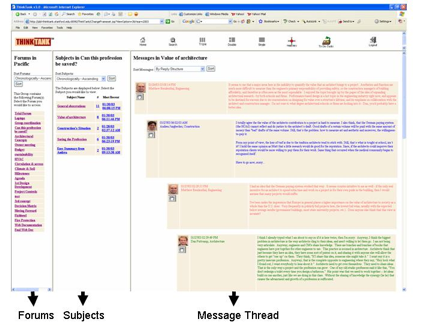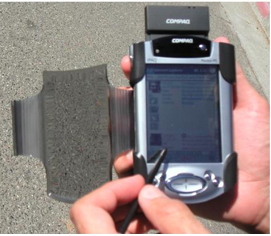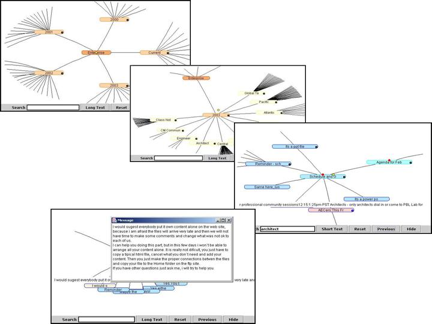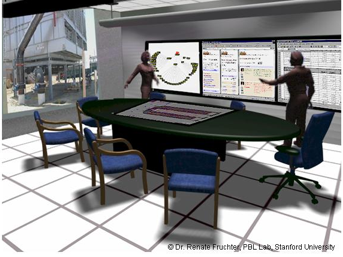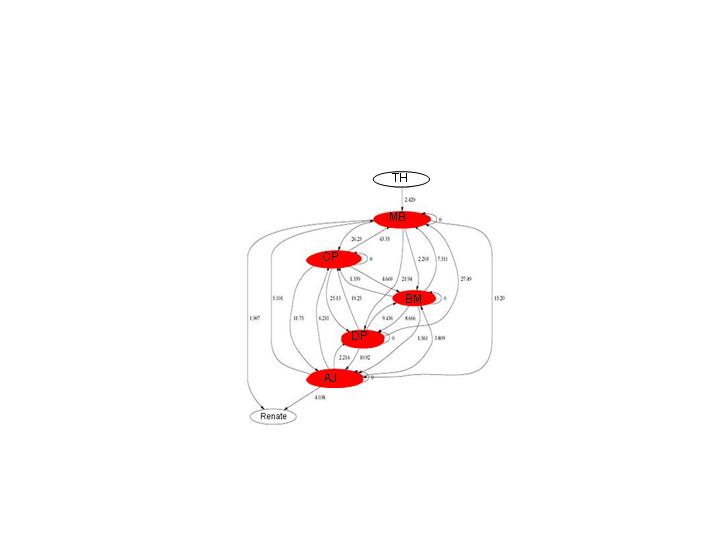Think Tank
Peter Demian, Mahesh Hardikar, and Renate Fruchter
Sponsored by : PBL Lab, Obayashi Corporation
1998-to date
ThinkTank is a discussion forum environment we developed to effectively support project specific asynchronous communication and collaboration activities in distributed teams. ThinkTank functionalities evolved based on ethnographic studies of the state-of-practice in industry and academia focused on the cross-disciplinary project team communication needs. It provides many of the advantages of face-to-face team meetings combined with the utility of e-mail and the organization of database technology. ThinkTank facilitates A/E/C project team members to create, capture, archive, share, email, reply, attach additional documents, track, sort, search, and re-use data, information, and knowledge. The underlying Microsoft Access® or Oracle® database is organized by groups, with each group having a private, password-protected, virtual asynchronous meeting room. Within the group meeting rooms the content is organized based on the ?book? metaphor with three levels of organization: Forums representing key topics or project phases for similar to book chapters, Subjects representing issues brought up within a Forum, similar to section within a chapter of a book, and threaded Messages representing the actual ideas captured and shared among team members, similar to the paragraphs within a section of a book.
Fruchter, R., and Luth, G., ThinkTank a Web Based Collaboration Tool, Proc. of ASCE Structures Conference, Nashville, 2004.
Luth, G. and Fruchter, R. Web Based Standards, Proc. of ASCE Structures Conference, Nashville, 2004.
Fruchter, R., Demian, P., Yin, Z., Luth, G., Turning A/E/C Knowledge into Working Knowledge, Proc. of Computing in Civil Engineering Conference in conjunctions with ASCE National Convention, ed. Ian Flood, Nashville, 2003
ThinkTank Walker
Matt Breidenthal and Renate Fruchter
Sponsored by : PBL Lab, UPS Endowment
2003-2004
ThinkTank Walker is an asynchronous collaboration tool aimed to enhance the ThinkTank discussion forum and support mobile learners and workers when they are offline. It was designed and developed to allow users to (1) download messages or entire threads from ThinkTank on their mobile device (PDA, laptop, tablet, etc.), (2) edit these messages while on the move and offline (i.e., no GSM/GPRA, WiFi, or LAN connection), and (3) when back online, synchronize and upload the new messages and email notifications to the specific recipients that the user has created while in the offline session.
Think Tank Navigator
Senthil A. G. Singaravelu and Renate Fruchter
Sponsored by : PBL Lab, UPS Endowment
2003-2004
Viewing data from a large hierarchically organized archive is a difficult task. The user viewing the data should have a clear understanding of the structure and should be able to find the exact information with much ease. Considering the above factors we designed a graphical user interface to navigate, explore and view the content in ThinkTank discussion forum, called ThinkTank-Navigator It was inspired by the hyperbolic browser model developed by J. Lamping and R. Rao. ThinkTank-Navigator supports direct communication to the forum, advanced search, and multi browsing features, allowing the user to understand the structure of data organization during the navigation.
Think Tank - iRoom
Kushagra Saxena, Mahesh Hardikar, and Renate Fruchter
Sponsored by : PBL Lab, Obayashi Corporation
2003-2004
Architecture, Engineering, Construction (A/E/C) team members, while collaborating on building projects, rely on past experiences and content through the use of project design archives (whether in paper or digital format). Underutilization of potential knowledge in the decision-making process of data, information, and knowledge reuse is limited by access to these archives, due to sheer size, decontextualized content, and inconvenient access and presentation. This paper presents an integrated solution called ThinkTank-iRoom that leverages two technologies ThinkTank and iRoom (interactive Room) developed at Stanford. CoMem-iRoom addresses critical limitations, i.e., content, context, visualization and interactivity, constraining the process of collaborative exploration towards knowledge reuse and decision-making.
Influence Leaders in Global Teamwork
Renate Fruchter, Shubashri Swaminathan, Jyotika Prasad, Shohini Banerjee, Naohiro Matsumura, and Yukio Ohsawa
Sponsored by : PBL Lab
2004-to date
The process of designing and constructing modern buildings depends for its success on the effective communication of ideas among stakeholders with different backgrounds who are likely to be geographically distributed. Architecture, Engineering, and Construction (AEC) global project teamwork is communication intensive and relies heavily on synchronous and asynchronous information and collaboration technologies (ICT). The use of ICT shapes work processes and social interactions among team members, and team members reshape ICT and the way it is used. We explore in this study how an asynchronous ICT, called ThinkTank, shaped the work practice of design-construction global teams, and how the interaction with this ICT reshaped the purpose and benefits of its use. ThinkTank is a web-based asynchronous collaboration and discussion forum developed by the PBL Lab at Stanford University. We introduce the Influence Diffusion Model (IDM) that formalizes the process of identifying the influence of people, messages, and terms mathematically. Discovering who the influence leaders in project teams are can be beneficial and critical from a corporate management perspective, since they can guide or motivate the team towards successful actions and outcomes. We developed the ThinkTank-IDM integrated system. We demonstrate how the use of IDM applied in the context of AEC global teamwork discussion forums in ThinkTank can assist to identify influence leaders, influence topics, and social interaction dynamics over time. We use a ThinkTank testbed of fifty three project team forums archived over eight years to validate the ThinkTank-IDM system.
